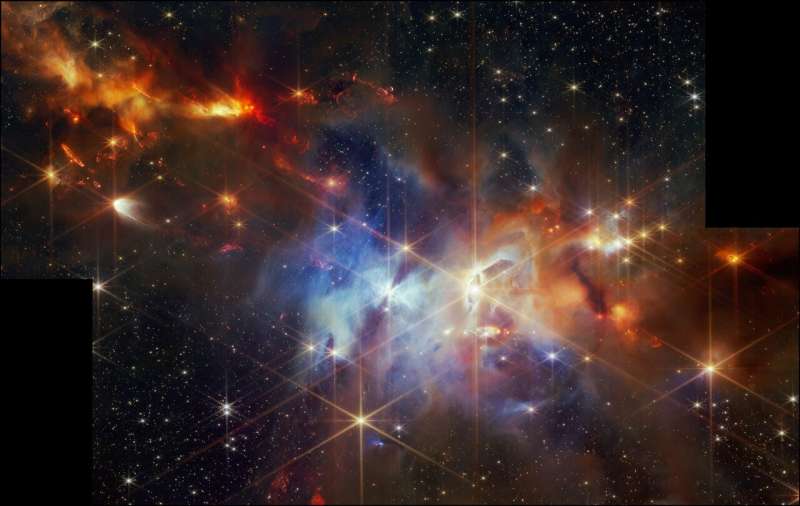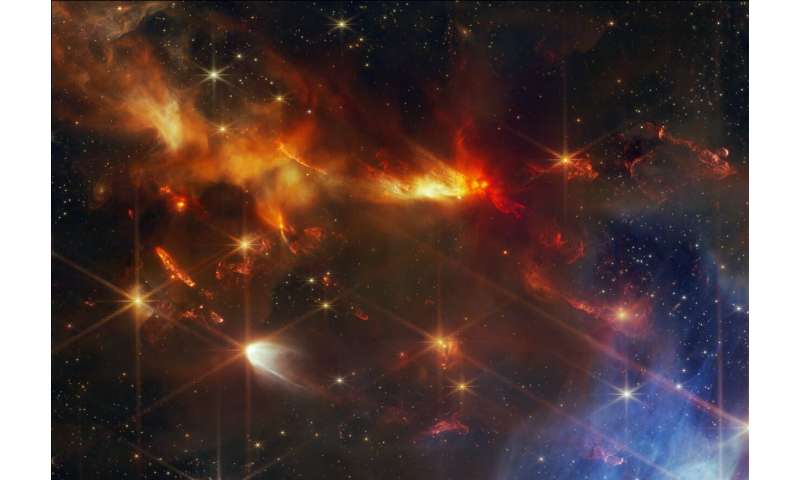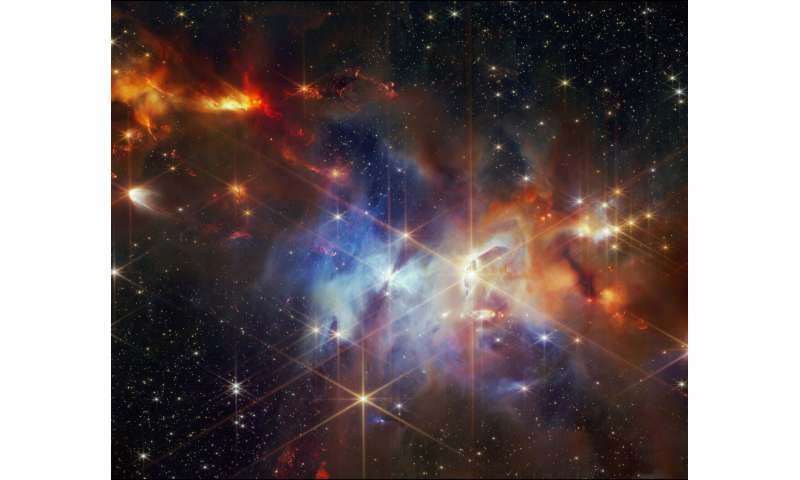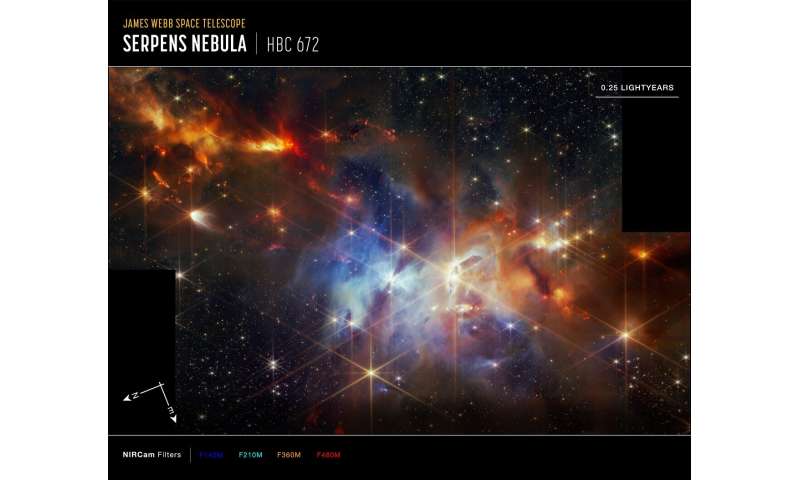This article has been reviewed according to Science X's editorial process and policies. Editors have highlighted the following attributes while ensuring the content's credibility:
fact-checked
peer-reviewed publication
trusted source
proofread
Striking new Webb image showing alignment of bipolar jets confirms star formation theories

For the first time, a phenomenon astronomers have long hoped to image directly has been captured by the NASA/ESA/CSA James Webb Space Telescope's Near-InfraRed Camera (NIRCam). In this stunning image of the Serpens Nebula, the discovery lies in the northern area of this young, nearby star-forming region.
The astronomers found an intriguing group of protostellar outflows, formed when jets of gas spewing from newborn stars collide with nearby gas and dust at high speeds. Typically, these objects have a variety of orientations within one region. Here, however, they are all slanted in the same direction, to the same degree, like sleet pouring down during a storm.
The discovery of these aligned objects, made possible only by Webb's exquisite spatial resolution and sensitivity at near-infrared wavelengths, is providing information about the fundamentals of how stars are born.
So, just how does the alignment of the stellar jets relate to the rotation of the star? As an interstellar gas cloud collapses in on itself to form a star, it spins more rapidly. The only way for the gas to continue moving inward is for some of the spin (known as angular momentum) to be removed.
A disk of material forms around the young star to transport material down, like a whirlpool around a drain. The swirling magnetic fields in the inner disk launch some of the material into twin jets that shoot outward in opposite directions, perpendicular to the disk of material.
In the Webb image, these jets are identified by bright red clumpy streaks, which are shockwaves caused when the jet hits the surrounding gas and dust. Here, the red color indicates the presence of molecular hydrogen and carbon monoxide. Webb can image these extremely young stars and their outflows, which were previously obstructed at optical wavelengths.
Astronomers say there are a few forces that potentially can shift the direction of the outflows during this period of a young star's life. One way is when binary stars spin around each other and wobble in orientation, twisting the direction of the outflows over time.
Stars of the Serpens Nebula
The Serpens Nebula is only one or two million years old, which is very young in cosmic terms. It's also home to a particularly dense cluster of newly forming stars (around 100 000 years old) at the center of this image, some of which will eventually grow to the mass of our sun.
Serpens is a reflection nebula, which means it's a cloud of gas and dust that does not create its own light but instead shines by reflecting the light from stars close to or within the nebula.
So, throughout the region in this image, filaments and wisps of different hues represent reflected starlight from still-forming protostars within the cloud. In some areas there is dust in front of that reflection, which appears here in an orange, diffuse shade.
This region has been home to other coincidental discoveries, including the flapping "Bat Shadow," which earned its name when 2020 data from the NASA/ESA Hubble Space Telescope revealed it to flap, or shift. This feature is visible at the center of the Webb image.
Future studies
The stunning image and the serendipitous discovery of the aligned objects are actually just the first step in this scientific program. The team will now use Webb's NIRSpec (Near-InfraRed Spectrograph) to investigate the chemical makeup of the cloud.
-

Credit: NASA, ESA, CSA, STScI, K. Pontoppidan (NASA's Jet Propulsion Laboratory), J. Green (Space Telescope Science Institute) -

Credit: NASA, ESA, CSA, STScI, K. Pontoppidan (NASA’s Jet Propulsion Laboratory), J. Green (Space Telescope Science Institute) -

Credit: NASA, ESA, CSA, STScI, K. Pontoppidan (NASA’s Jet Propulsion Laboratory), J. Green (Space Telescope Science Institute)
Astronomers are interested in determining how volatile chemicals survive star and planet formation. Volatiles are compounds that sublimate, or transition from a solid directly to a gas, at a relatively low temperature—including water and carbon monoxide. They'll then compare their findings to the amounts found in protoplanetary disks of similar-type stars.
These observations were made as part of the Webb General Observer program 1611 (PI: K. Pontoppidan). The team's initial results have been published in the Astrophysical Journal.
More information: Study: Joel D. Green et al, Why are (almost) all the protostellar outflows aligned in Serpens Main? (2024)
Journal information: Astrophysical Journal
Provided by European Space Agency




















